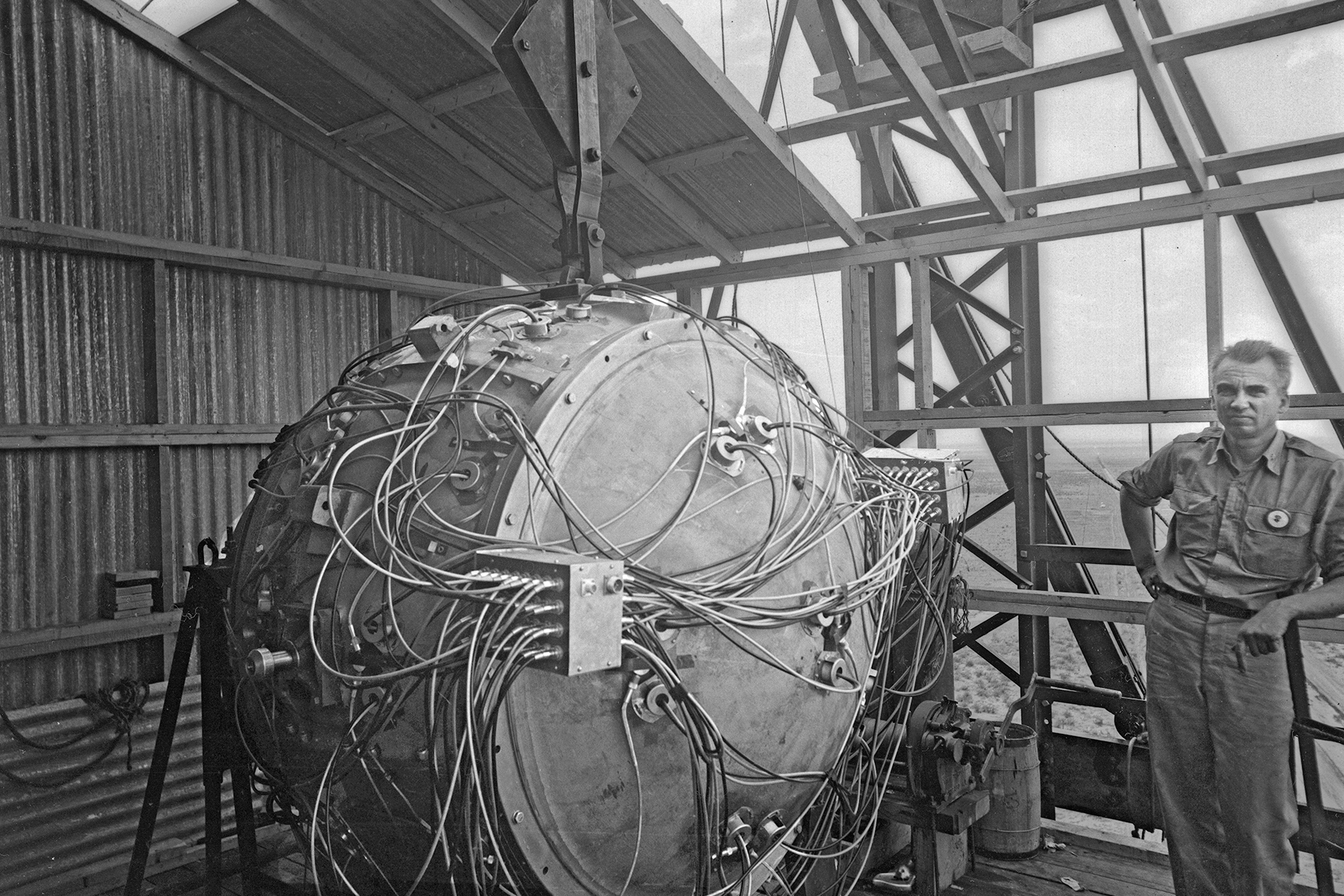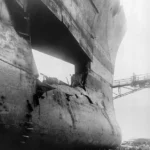In 1942, the United States launched its most ambitious and secretive wartime initiative. The Manhattan Project was a $2 billion research program that developed the world’s first atomic bombs, employing over 130,000 people across multiple secure facilities.
The project brought together brilliant scientific minds like J. Robert Oppenheimer, Enrico Fermi, and Richard Feynman. Operating under strict security at sites in Oak Ridge, Tennessee; Los Alamos, New Mexico; and Hanford, Washington, these scientists raced against time to harness nuclear fission for military use.
This massive endeavor changed warfare and international relations forever. The successful test of the first atomic bomb at Trinity Site in July 1945, followed by the bombings of Hiroshima and Nagasaki, ushered in the atomic age and reshaped global power dynamics for decades to come.
Origins of the Manhattan Project
The U.S. atomic weapons program emerged from growing scientific understanding of nuclear fission and fears that Nazi Germany might develop an atomic bomb first.
Einstein’s Letter to Roosevelt
In August 1939, physicists Leo Szilard and Eugene Wigner convinced Albert Einstein to write a letter to President Franklin D. Roosevelt. The letter warned about Germany’s potential development of an atomic weapon using uranium.
Einstein’s letter emphasized that recent scientific breakthroughs could lead to extremely powerful bombs. He urged Roosevelt to secure uranium supplies and accelerate American atomic research.
The letter reached Roosevelt’s desk on October 11, 1939. Roosevelt responded by creating the Advisory Committee on Uranium, marking the first U.S. government action toward atomic weapons development.
Government Mobilization
The U.S. government launched the S-1 Project in June 1941, dedicating $6,000 to atomic research under the Office of Scientific Research and Development (OSRD).
In December 1941, the attack on Pearl Harbor accelerated U.S. atomic efforts. The program received its code name “Manhattan Project” in August 1942, after the Manhattan Engineer District of the Army Corps of Engineers.
The U.S. Army placed Brigadier General Leslie Groves in charge of the project on September 17, 1942. Groves immediately purchased key sites and recruited top scientists, transforming the theoretical program into a massive engineering endeavor.
Leadership and Organization
The Manhattan Project operated under a unique dual leadership structure combining military command with scientific direction, spanning multiple secret facilities across the United States.
General Leslie Groves
General Leslie R. Groves served as the military head of the Manhattan Project from September 1942. The Army Corps of Engineers officer managed the project’s $2 billion budget and coordinated construction of facilities.
Groves made critical decisions about project sites and security protocols. He selected Robert Oppenheimer as scientific director despite security concerns about Oppenheimer’s past political associations.
His forceful leadership style and organizational skills proved essential for completing the massive project on schedule. Groves handled logistics, secured rare materials, and maintained strict compartmentalization of information.
Scientific Directors
J. Robert Oppenheimer led scientific work as director of Los Alamos Laboratory from 1943-1945. His brilliant mind and ability to coordinate diverse scientific teams earned him the nickname “father of the atomic bomb.”
Other key scientific leaders included Ernest Lawrence at Berkeley, Arthur Compton at the University of Chicago, and Harold Urey at Columbia University. Each supervised crucial research components.
James B. Conant and Vannevar Bush provided high-level scientific oversight as directors of the National Defense Research Committee and Office of Scientific Research and Development.
Project Sites
Los Alamos Laboratory in New Mexico served as the main scientific facility where the bombs were designed and assembled. The remote mesa location provided necessary isolation and security.
Oak Ridge, Tennessee housed uranium enrichment plants and employed over 75,000 workers. The X-10 Graphite Reactor, Y-12 electromagnetic separation plant, and K-25 gaseous diffusion plant operated there.
The Hanford Engineer Works in Washington state produced plutonium in its B Reactor. The site encompassed nearly 600 square miles along the Columbia River.
Chicago’s Metallurgical Laboratory conducted early chain reaction research under Stagg Field stadium. Additional research occurred at Columbia University and the University of California, Berkeley.
Scientific Breakthroughs and Challenges
The Manhattan Project achieved multiple groundbreaking scientific advances in nuclear physics, material production, and engineering between 1942 and 1945. These developments required solving complex technical problems while racing against time.
Fission Research
Scientists at the University of Chicago achieved the first controlled nuclear chain reaction on December 2, 1942, under the leadership of Enrico Fermi. The team constructed Chicago Pile-1, a reactor using uranium and graphite blocks.
The successful chain reaction proved that nuclear energy could be harnessed, marking a crucial milestone for the project. This breakthrough validated theories about nuclear fission and provided data for larger-scale operations.
Key experiments determined the critical mass needed for an explosive chain reaction. Scientists developed innovative techniques to measure neutron multiplication and reaction rates.
Plutonium Production
Engineers designed and built the world’s first large-scale nuclear reactors at Hanford, Washington. The B Reactor began producing plutonium in September 1944, followed by additional reactors.
The facilities faced significant cooling challenges, requiring massive water pumping systems from the Columbia River. Engineers developed remote handling systems to manage highly radioactive materials safely.
Chemists created new separation processes to extract pure plutonium-239 from irradiated uranium fuel. The bismuth phosphate process proved most effective for industrial-scale production.
Uranium Enrichment
Scientists developed three different methods to enrich uranium at Oak Ridge, Tennessee: electromagnetic separation, gaseous diffusion, and thermal diffusion.
The Y-12 facility used massive electromagnetic separators called calutrons to isolate U-235. This process required significant amounts of silver borrowed from the U.S. Treasury for magnet windings.
The K-25 gaseous diffusion plant became the most successful enrichment facility. It used thousands of barriers to separate uranium isotopes in gaseous form.
Early technical setbacks with barrier materials nearly derailed the diffusion program. Engineers solved these issues by developing new nickel barriers and improved seals.
Life at the Project Sites
The Manhattan Project’s secret facilities became unique communities where thousands of workers and scientists lived under strict security while maintaining aspects of normal daily life.
Secrecy and Security
Military police monitored all entrances and exits at project sites. Workers could not discuss their jobs with anyone, including family members, and mail was heavily censored.
Code names masked the true nature of locations and materials. Oak Ridge was known as “Site X,” while Los Alamos became “Site Y.” Scientists used “tube alloy” to reference uranium in communications.
Workers wore badges with unique numbers instead of names. Security clearances determined which areas employees could access, with colored badges indicating different authorization levels.
Community and Culture
Despite restrictions, residents created vibrant communities. Oak Ridge built schools, movie theaters, and recreation centers for the 75,000 people who lived there by 1945.
Los Alamos organized social clubs, dances, and theater productions. Scientists’ families hosted dinner parties where work topics were strictly forbidden.
The sites provided housing based on job rank. Scientists received comfortable homes, while construction workers lived in basic dormitories or trailers.
Children attended schools without knowing their parents’ classified work. Teachers avoided questions about what happened at the facilities.
Trinity Test and the Atomic Bombs
The world’s first nuclear explosion occurred on July 16, 1945, in New Mexico, leading to the development of two atomic bombs that were dropped on Japan in August 1945.
Trinity Test
Scientists detonated the first atomic bomb at 5:29 AM at the Alamogordo Bombing Range in New Mexico. The explosion yielded an estimated force of 21 kilotons of TNT, creating a mushroom cloud that rose 7.5 miles high.
The blast created a crater 10 feet deep and 1,100 feet wide, turning the desert sand into radioactive green glass nicknamed “trinitite.”
J. Robert Oppenheimer famously quoted the Bhagavad Gita upon witnessing the explosion: “Now I am become Death, the destroyer of worlds.”
Hiroshima
On August 6, 1945, the B-29 bomber Enola Gay dropped the uranium bomb “Little Boy” on Hiroshima, Japan. The bomb detonated at 8:15 AM local time, approximately 1,900 feet above the city.
The explosion generated temperatures reaching 7,200°F and winds up to 624 mph. The blast killed an estimated 70,000 people instantly, with thousands more dying from radiation exposure in the following months.
The bomb destroyed about 70% of Hiroshima’s buildings across 5 square miles.
Nagasaki
Three days after Hiroshima, on August 9, 1945, the B-29 Bockscar dropped the plutonium bomb “Fat Man” on Nagasaki. The bomb exploded at 11:02 AM local time.
The blast killed approximately 40,000 people instantly and destroyed 44% of the city. The mountainous terrain of Nagasaki partially limited the bomb’s destruction compared to Hiroshima.
Japan announced its surrender on August 15, 1945, six days after the Nagasaki bombing.
Ethical and Philosophical Debates
The development of atomic weapons sparked intense moral questioning among scientists and civilians about the use of nuclear technology for mass destruction. Ethical concerns centered on both the immediate casualties and long-term implications for humanity.
Scientists’ Reflections
Many Manhattan Project scientists experienced deep moral conflicts about their role in creating such a devastating weapon. Robert Oppenheimer famously quoted the Bhagavad Gita after the Trinity test: “Now I am become Death, the destroyer of worlds.”
Leo Szilard, who initially advocated for the bomb’s development, later circulated a petition urging President Truman not to use it against Japan without warning.
Albert Einstein, whose letter to President Roosevelt helped initiate the project, expressed profound regret about his indirect involvement. In 1947, he stated that had he known Germany would not develop the bomb, he would have never advocated for its creation.
Public Perspective
The American public initially supported the bomb’s use, with 85% approving of the decision in a 1945 Gallup poll. This support stemmed from desires to end the war quickly and save American military lives.
Critics emerged as radiation effects became known. Religious leaders questioned the morality of targeting civilian populations. The bombings of Hiroshima and Nagasaki sparked global anti-nuclear movements.
Public debate intensified during the Cold War arms race. Peace activists and scientists alike warned about the dangers of nuclear proliferation and advocated for international control of atomic weapons.
Legacy and Impact
The Manhattan Project fundamentally altered global politics and scientific research while raising critical questions about nuclear weapons and their control. Its technologies and discoveries continue to influence military strategy, international relations, and peaceful nuclear applications.
Nuclear Arms Race
The Soviet Union detonated its first atomic bomb in 1949, sparking decades of nuclear proliferation between world powers. The U.S. and USSR rapidly expanded their nuclear arsenals through the 1950s and 1960s.
Scientists and military leaders who worked on the Manhattan Project split into opposing camps. Some advocated for international control of atomic weapons, while others pushed for continued weapons development.
By 1960, the UK, France, and China had also developed nuclear weapons. This expansion led to the doctrine of “mutually assured destruction” as a deterrent against nuclear war.
Nuclear Regulation and Control
The U.S. Congress passed the Atomic Energy Act in 1946, transferring nuclear research and weapons development from military to civilian control under the Atomic Energy Commission.
The International Atomic Energy Agency formed in 1957 to promote peaceful nuclear applications and prevent weapons proliferation. Its inspection system became a model for nuclear safeguards.
The 1963 Limited Test Ban Treaty prohibited atmospheric nuclear testing. This agreement marked the first major step toward international nuclear arms control.
Scientists from the Manhattan Project helped establish the Bulletin of the Atomic Scientists to inform the public about nuclear risks and advocate for weapons control.
References
- Atomic Heritage Foundation (n.d.) – The Manhattan Project: History, Science, and Legacy. Link
- U.S. Department of Energy (n.d.) – The Manhattan Project: A Timeline of Nuclear Development. Link
- Los Alamos National Laboratory (n.d.) – The Role of Los Alamos in the Manhattan Project. Link
- National Security Archive (n.d.) – Declassified Documents on the Manhattan Project and the Atomic Bomb. Link
- Library of Congress (n.d.) – The Einstein-Szilard Letter and the Beginning of U.S. Nuclear Research. Link
- The Bulletin of the Atomic Scientists (n.d.) – The Legacy of the Manhattan Project and Nuclear Proliferation. Link
- History.com (2018) – The Manhattan Project: How the Atomic Bomb Was Built. Link




